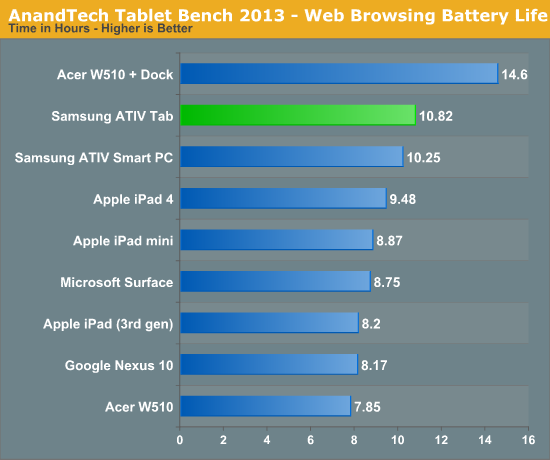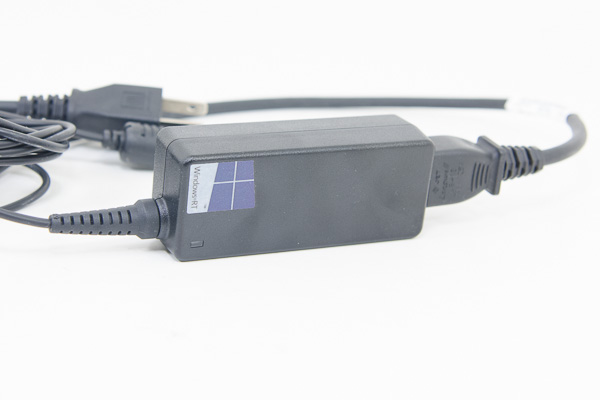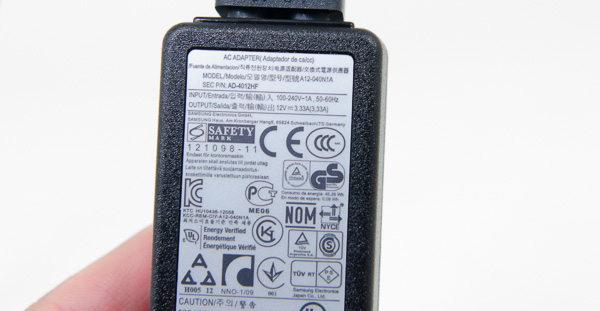Samsung ATIV Tab Review: Qualcomm's First Windows RT Tablet
by Anand Lal Shimpi on January 3, 2013 6:00 AM EST- Posted in
- Tablets
- Samsung
- Qualcomm
- Mobile
- Windows RT
Charging & Battery Life
The ATIV Tab ships with a two piece power adapter that looks a lot like what you'd get with a Samsung notebook. The adapter is rated for 3.33A at 12V, but in practice it'll draw a max of 11.3W while charging (but not powering) the ATIV Tab.
The power supply must be fairly inefficient because even after 2.68 hours of pulling over 10W, the ATIV Tab's 30Wh battery is only 68% charged. After 3.44 hours the battery was at 85% of its fully charged capacity and it's not until 5.25 hours before the ATIV Tab will report being fully charged (after 4.5 hours it only has around 5% left to go).
The good news is that using the ATIV Tab while charging it doesn't appear to slow charge times down at all. The ATIV Tab is limited to pulling ~11W from the wall while charging, but if you're using the tablet while charging the power adapter will draw several more watts.
Battery Life
We've started running our new smartphone web browsing battery life test on tablets as well. If you missed its introduction in our iPhone 5 review, here's a bit about the new test:
We regularly load web pages at a fixed interval until the battery dies (all displays are calibrated to 200 nits as always). The differences between this test and our previous one boil down to the amount of network activity and CPU load.
On the network side, we've done a lot more to prevent aggressive browser caching of our web pages. Some caching is important otherwise you end up with a baseband/WiFi test, but it's clear what we had previously wasn't working. Brian made sure that despite the increased network load, the baseband/WiFi still have the opportunity to enter their idle states during the course of the benchmark.
We also increased CPU workload along two vectors: we decreased pause time between web page loads and we shifted to full desktop web pages, some of which are very js heavy. The end result is a CPU usage profile that mimics constant, heavy usage beyond just web browsing. Everything you do on your device ends up causing CPU usage peaks - opening applications, navigating around the OS and of course using apps themselves. Our 5th generation web browsing battery life test should map well to more types of mobile usage, not just idle content consumption of data from web pages.

Battery life for the ATIV Tab is amazingly good. With a smaller display but the same sized battery, the Qualcomm powered tablet is able to best Intel's Clover Trail powered ATIV Smart PC. The display discrepancy makes drawing a direct conclusion here difficult, but we'll soon be able to repeat our Clover Trail power experiments with a Krait based tablet to see how close those two SoCs really are when it comes to power consumption.
At 10.82 hours off of a 30Wh battery, the ATIV Tab does better than even the 4th generation iPad.
Our video playback test remains unchanged from previous tablet reviews. Here I'm playing a 4Mbps H.264 High Profile 720p rip I made of the Harry Potter 8 Blu-ray. The full movie plays through and is looped until the battery dies. Once again, the displays are calibrated to 200 nits:

Video decode battery life is outstanding from the ATIV Tab - we finally have a tablet that can equal Apple's iPad in terms of battery life when playing back video. There's a clear advantage here over the Clover Trail based platforms, and obviously compared to the Tegra 3 based Surface RT as well. I believe what we're seeing here are the benefits of TSMC's 28nm LP process delivering extremely low leakage while the SoC is mostly idle. Qualcomm's video decode block seems to do a great job at being very power efficient here.













42 Comments
View All Comments
snoozemode - Thursday, January 3, 2013 - link
Lets hope that is the case. But if that is what Blue is, what about current Windows RT devices? And WP8 devices? Will they too be left in the cold as WP7.5 devices? For me it feels like Microsoft has created this massive pile of mess that I'm not sure how long it will take before it's sorted out. I mean my Windows 8 computer still has two separated Internet explorers that doesn't sync favorites between eachother, and this is in year 2013.Silent_Rage - Thursday, January 3, 2013 - link
The current RT and WP8 devices will be upgraded to Blue as well. I'm positive of this since Blue is a smaller form of an update as compared to the usual cycle we've seen with Windows in the past. Windows Blue will be the first "annual" update to Windows and we will see granular changes to Windows RT. On the backend, we will see a shift to align the two OSs (RT and WP8) to share the same APIs, more so than what we're seeing today.ninjacut - Thursday, January 3, 2013 - link
I actually prefer Microsoft approach of not using Phone OS on a tablet, firstly it simply becomes a more productive device and can handle content creation activity better than the Phone OS. Secondly, the way performance is improving in these SOC's the Phone OS will need to catch-up in features. This is already happening with Android doing multi-user and split screen like WRT and will continue to do so. Microsoft has a good advantage at this point.Regarding the 7inch form factor, WRT can perform well but certain features will make less sense such as the desktop. But its again advantage and not a disadvantage.
The challenge is to release WRT 7inch tablet, at the right price asap!
snoozemode - Friday, January 4, 2013 - link
My point is that the WRT UI could stay as it is, the OS would just change UI depending on screen size as Android did in ICS.Regarding desktop in WRT, can't really see the point of having it since you can't run any legacy programs anyway. It's basically there to run Office 2013. Make a Metro UI Office and remove Desktop.
Wolfpup - Thursday, January 3, 2013 - link
This sounds like a dumb question, but do Windows Phone 8 programs also run on Windows 8 and RT? P8 runs P7 stuff, and I've been assuming that RT and real Windows 8 can run Windows Phone 7 and 8 programs too, but not necessarily optimized for the display, iOS style...but I actually have no idea if that's the case.Also...I have no idea if it's even possible to back up metro programs. I'm not a huge fan of iOS, but one of the things it does right is let you back up programs to a PC, so you can manage them and don't have to redownload multiple GB onto a new device, or when you're juggling storage.
Really disapointed Metro isn't open though...otherwise Windows 8 is what I've wanted since before the original iPad-a real PC that has an optional tablet interface...but to be a real PC it has to be OPEN...ironically Android is open (technically), Windows 8 as a desktop OS is open, but metro isn't :(
damianrobertjones - Thursday, January 3, 2013 - link
1080p 'real' resolution on a device like this would feature text so small you wouldn't be able to read. Increase the DPI? Might as well just drop straight to 1366x768.Marketing.
DeciusStrabo - Friday, January 4, 2013 - link
Like Android Windows 8 is able to display Metro-Apps independently from the physical resolution, meaning they always use a logical resolution (which makes them look like Babbies first computer-Apps on my 27" screen, since all elements and letters are huge, not taking advantage of the space offered, simply making everything scale up.However the advantage is of course that this way they can use more pixels to display elements, making them look smoother (what Apple does with Retina, but more flexible as you aren't limited to multiples of their logical resolutions and the weird and resources intense offscreen rendering process).
So 1080p would be great to have on Windows RT/WP8 devices too, as it just means smoother and more readable UI elements, not smaller UI elements (disadvantage on desktops, advantage on mobile devices).
mayankleoboy1 - Thursday, January 3, 2013 - link
It has Adreno225.How about NOOOO
killerclick - Thursday, January 3, 2013 - link
Lol @ 1366x768Lol @ dead platform
Lol @ available storage
It's worth $350 at most (not even that if you don't need Office), although seeing how Metro devices are doing, they should be offering more for less.
BrokenCrayons - Thursday, January 3, 2013 - link
I'm not at all a huge fan of Windows RT devices since I just don't see the value added in limiting one's computing to a keyboard-less device or having to add a keyboard at additional cost to perform data entry at a reasonable speed, but tablets have their place as content consumption and entertainment devices. They're also the current wizbang thing to purchase, replacing other fads like 3D TV and netbooks.All that said, there's really nothing wrong with the screen's resolution given the 10 inch size. Yes, there's lots higher resolution devices available, but to make those devices usable, objects on screen must be scaled to a reasonable size, negating lots of the advantages while costing in battery life and platform performance managing pixels that are simply there to be checkbox specification for marketing.
The platform isn't dead yet. It might go the way of Windows Mobile someday, but it's sort of early to assume such is the case.
The device storage is pretty disappointing. Sure you can add memory via SD or an external devices, but it would be nice to be able to use more of what you're paying for OR for the cost of additional storage to be lower. One of the things that I don't care much for with RT (and 8-based tablets as well) is the large footprint of the OS. It hasn't gotten much worse since 7's launch, but the move from rotating hard disks to flash memory has certainly made getting lots of storage an expensive prospect. Power consumption and durability are nice, but vendors do make you pay if you want to keep much information on the device itself.